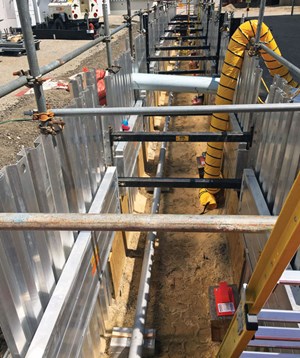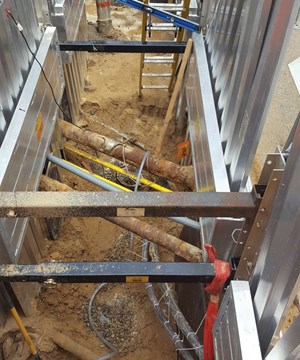July 2019 Vol.74 No. 7
Features
Unique Shoring Solution for Fire-Safety Installation at Nuclear Plant
James McRay
Sometimes redundancy is a good thing, especially when considering safety at one of the country’s nuclear generation plants. All systems must be working efficiently with back-ups to the back-ups. That is why one such nuclear power plant contracted the installation of a new generator-powered, fire-suppression system to back up the existing power-dependent, fire-suppression system.

This particular “excavation” project presented a unique challenge for the contractor charged with installing more than 1,000 linear feet of pipe and conduit. Most of the high-pressure water pipeline was installed underground at the facility. Normally, this would not be a problem for any experienced underground utility contractor. However, there are many
pipes and utilities already in the ground at the nuclear plant, crisscrossing the path of the new fire-safety system.
Non-traditional pipeline installation
Knowing it needed a little help with the trench shoring aspects of the project, the contractor called in the trench safety specialists at Efficiency Production, a leading manufacturer of trench shielding and shoring equipment.
“The contractor’s project manager came in to look at some shoring equipment and talk about potential solutions for the underground project at the power plant,” said Allan Baron, Efficiency’s national sales manager. “We’ve worked with the contractor before, so we understood the challenges they were facing.”
The original idea Baron pitched was to use a Shore-Trak Sheeting Guide Frame, a system for navigating cross-trench utilities. “However, after taking into consideration the excavation safety requirements at the plant, it became evident that Shore-Trak wasn’t going to work,” admitted Baron.
“The biggest prohibiting factor was that almost all excavation at the nuclear facility is done exclusively by hydro-excavation,” explained Jim Hamilton, Efficiency’s sales and rental manager who conducted the initial site assessment and provided on-site support. “There is no ‘mechanized digging’ allowed at all;
no excavators, only vac-trucks.”
“With our initial shoring plan ruled out, we needed to put our heads together and come up with a better trench safety mousetrap,” Baron asserted.
Solution found
The better mousetrap turned out to be Efficiency Production’s Build-A-Box modular aluminum shoring system
with new, integrated Sheeting Guide Frames. This utilizes lightweight corrugated aluminum sheets to shore closely around existing cross-trench utilities. The guide frame panel integrates seamlessly into any Build-A-Box configuration, and the aluminum sheets can be installed by hand.
“We’ve used this system for years, so we had a good idea that the new sheeting frames for the system were going to work well, and they did,” said the contractor’s project supervisor. “The key was working out a process to vac the trench and install the guide frame and sheets at the same time; even backfilling some dirt behind the frames to keep them in place. Once we had the technique down, the system went in very quickly.”
The contractor used more than 80 guide frame panels and almost 650, 8-foot-long corrugated aluminum sheets to shore the entire length of open trench. All told, pipes, conduits and duct-bank bundles crossed the primary trench at 22 points.
One other advantage of the all-aluminum sheets is that the contractor could cover the new high-pressure water pipe and other conduit bundles with flowable fill directly against the sheets, with no forms being necessary. •
FOR MORE INFO:
Efficiency Production, (800) 552-8800, efficiencyproduction.com





Comments